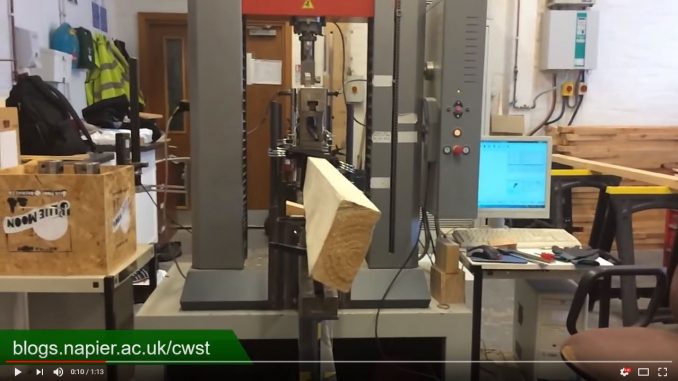
This is a guest post by Mike Jarvis, Honorary Research Fellow at the School of Chemistry at Glasgow University and one of the original architects of the SIRT project. Mike has supervised several PhDs relating to timber and forestry – including some of the key people now working on our research.
Twist is the most important kind of distortion during kiln-drying of sawn timber.
Twist can be a cause of rejection during grading, when the moisture content is 20% or less. Problems can also feed back up the supply chain when timber twists after sale, due to further drying when improperly stored on the construction site or in service in a centrally heated building. A recent PhD project at Glasgow University and trials at Edinburgh Napier University sought ways to minimise twist.
Twist can be – (1) a cause of rejection after drying to the intended MC, e.g. 20%; or (2) it can result from inadvertent drying after sale, either through inappropriate storage on-site, or (3) due to very dry conditions in service. Problems 2 and 3 are the customer’s responsibility but are nevertheless undesirable.
Reducing twist during drying. This is routinely achieved by appropriate restraint in the kiln, but there is room to optimise the way in which restraint is applied and to share good practice. Smaller pack sizes might improve restraint after kilning and help to reduce twist after sale, but new research would be needed to explore this approach.
Segregating out kiln-dried timber that will twist if dried further after sale. Twist at 20% moisture is a good predictor of the increased level twist at any lower moisture content. Roughly, a 1% decrease in moisture content leads to a 5% increase in twist. If the nature of any group of customers means that it would be desirable to allow for drying to excessively low moisture content on the building site or in service, the most reliable way to do this is simply to be more severe than the standard demands when grading the kiln-dried product for twist.
Early segregation based on predictions of twist. It would be better to identify and segregate out timber with a propensity to twist earlier in the chain, ideally in the forest. The problem is that the earlier the test, the less reliable the prediction. One reason is that wood right at the pith normally twists the most, but is hidden from view in logs or standing trees. So, spiral grain leads to twist, but the grain angle immediately under the bark is not what matters.
Segregation in standing trees. There is some correlation between logs or trees with low stiffness and the extent of twist in the central battens when dried, so that successful acoustic selection for MOE at stand level might be expected to lead, as a bonus, to some reduction in the incidence of twist. But any such effect would be quite small and hard to measure.
Predicting twist in logs. There is scope for research on novel methods for predicting severe twist at log stage, allowing either diversion of logs to other end uses or choosing an appropriate cutting pattern. There are two independent approaches that might work and could potentially be combined, if the equipment were available: using CT-scanning to measure grain angle close to the pith where twisted battens would be sawn from: and using acoustic scanning to measure stiffness, which correlates inversely with twist. Modelling of twist would help to evaluate cutting patterns.
Predicting twist in green sawn timber. These two approaches for predicting twist in logs are also possible if sawn timber is green graded. Acoustic green grading alone would then have a better chance of success than for logs, because the centrally located battens that are most susceptible to twist normally have lower stiffness than the outer battens. Acoustic green grading for MOE will thus automatically segregate out some battens that would twist badly when dried.

Leave a Reply
You must be logged in to post a comment.